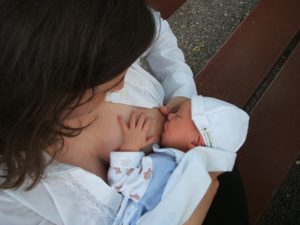Most mothers eagerly await the end of the 9 months of pregnancy, so that after childbirth they can breastfeed their baby and enjoy the pleasure of that moment. But some struggle with many difficulties or are even unable to feed their baby for various reasons.
What is Cross-Nursing?
Cross-nursing is the act of a woman who is still lactating, breastfeeding the baby of another mother who cannot breastfeed for some reason. Even though it may seem like a great solution and a beautiful gesture, it is not, and there are many risks with this type of option. Today it has been proven that there are many risks behind cross-nursing, which is why it has been banned by law in Brazil by the Ministry of Health. Therefore, if the mother is unable to breastfeed her baby, other methods are offered to resolve the situation. Risks of Cross-Nursing It is proven that cross-nursing can be very dangerous for the baby. One of the greatest risks is the baby being infected by a disease that can be transmitted through milk, such as hepatitis B, AIDS, hepatitis C, herpes virus, mononucleosis, as well as other viral diseases like rubella, mumps, and measles. There is no proof that the use of certain medications harms the baby’s health. And even if the wet-nurse appears healthy and well, is known to you, or even a family member, she may have an asymptomatic disease that she herself is unaware of. For this reason, cross-nursing is still a major risk for the baby, as diseases can be transmitted through breast milk and the baby does not yet have antibodies needed to fight any type of disease, bacteria, or infection. We know that breast milk is a food rich in antibodies, vitamins, and supplies all nutritional needs. It is important for the development of the immune system and the prevention of allergies and intolerances, being the best for each baby at the beginning of their lives. However, breast milk is unique and specific for each baby. A woman’s body will recognize what her child needs and produce specific milk for the baby. It may cause health risks for the infant if they are breastfed by another woman. 
What Are Milk Banks?
Human Milk Banks (BLH) are linked to children’s hospitals and maternity hospitals, and support breastfeeding, ensuring that many babies receive the milk they need to grow strong and healthy. Unfortunately, not everyone knows about this, but in Brazil there are more than 215 Milk Banks, and it is a major recommendation by doctors for mothers who are overproducing milk or have extra milk, that they donate this milk to Milk Banks. The big difference between milk from a Milk Bank and milk donated directly by another mother is that these banks have a thorough registration process for donations, high hygiene standards and control measures, and various tests are performed to check that the donor has no disease or anything that could harm the baby. If your baby needs milk or for some reason you are unable to breastfeed, look for a Milk Bank closest to your home. Even though the milk comes from another woman, it goes through a pasteurization process which leaves the milk free from any impurity and safe for the baby to consume, and without the risks of cross-nursing. One way to avoid cross-nursing is to be able to breastfeed your baby with your own milk, thus eliminating the risks of cross-nursing. Here are some tips that may help you produce more milk during breastfeeding.
How to Produce More Milk?
Massaging the breasts at the end of pregnancy can be a good way to help the milk come in. One way is to make circular movements around the nipple slowly, repeating about 5 times. This massage helps circulation, which makes the milk descend. Another way is to massage by placing both hands on each side of the breast and moving towards the nipple, then the opposite way with one hand below and the other above the breast, in the same manner. This can be done 1 to 3 times a day. Maintain a good diet – A healthy diet can make all the difference in your milk production. It’s always good to watch your nutrition and eat the right amount of foods that are rich in Omega-3. Eating fresh fruit, vegetables, greens, fish, vitamins, minerals, whole grains, keeping a healthy diet during pregnancy will help regulate your milk production, and it’s important to maintain healthy eating throughout the breastfeeding period as well. Multivitamins appropriate for this phase are also recommended. FamiGesta, for example, has all the necessary nutrients and especially Methylfolate (the active form of folic acid), which is essential for the baby. It can be taken during breastfeeding, at least up to 6 months. Drink plenty of water – Staying hydrated during breastfeeding is essential. It’s important to drink at least 3 liters of water a day, which helps prevent the well-known swelling and those bothersome urinary tract infections that often occur during pregnancy. By following some medical recommendations and even those from mothers and grandmothers, it’s possible to have successful breastfeeding with plenty of milk. In case of doubts, talk to your baby’s pediatrician and see what’s best to solve your difficulties. See Also: How to Increase Breast Milk – Start of Breastfeeding Photo: seeseehundhund











